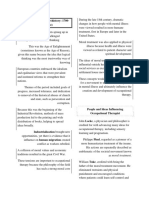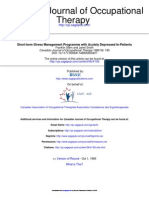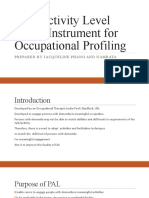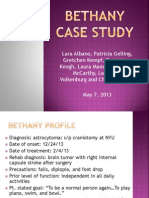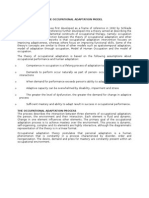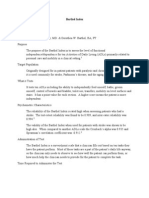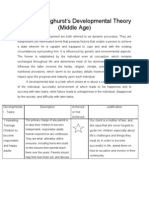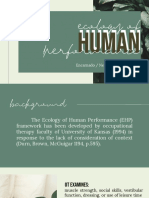CPPFFFFF
CPPFFFFF
Uploaded by
Edu EduCopyright:
Available Formats
CPPFFFFF
CPPFFFFF
Uploaded by
Edu EduOriginal Title
Copyright
Available Formats
Share this document
Did you find this document useful?
Is this content inappropriate?
Copyright:
Available Formats
CPPFFFFF
CPPFFFFF
Uploaded by
Edu EduCopyright:
Available Formats
THEORY MEETS PRACTICE
The Canadian Practice Process
Framework: Using a conscious approach
to occupational therapy practice
Column Editor: Heidi Cramm
Kara Fazio, Emma Hicks, Courtney Kuzma, Persis Leung, Arlee Schwartz, Mary Stergiou-Kita
The Canadian Practice Process Framework (CPPF) was between the client and therapist, is highlighted
developed by Helene Polatajko, Janet Craik, Jane Davis throughout all eight action points of the CPPF.
and Elizabeth Townsend (2007) and introduced in
Enabling Occupation II: Advancing an Occupational
“The CPPF takes into account the knowledge, experiences,
Therapy Vision for Health, Well-Being and Justice
and personal values that both the client and therapist
through Occupation. The CPPF was designed to enable bring with them into the therapeutic relationship.”
occupational therapists to facilitate client-centred,
evidence-based practice, as well as participate in
reflective practice (Craik, Davis, & Polatajko, 2007). The The CPPF can be applied to numerous practice
CPPF illustrates eight key action points that guide the settings, can be used in an interdisciplinary setting,
therapeutic process in occupational therapy practice and allows the therapist to engage both individuals
(Davis, Craik, & Polatajko, 2007). The first action point, and groups of clients in the therapeutic process.
enter and initiate, represents the first point of contact Using the fictional case scenario of Maria and
between the client and therapist where a collabora- Rebecca, we will provide a brief critique of the CPPF,
tive decision is made to either engage in or terminate highlighting its specific applications and advantages
the practice process. The second action point allows for occupational therapy practice. We will focus our
the therapist and client to set the stage by clarifying discussions on the flexibility, consideration of context,
expectations and assumptions about the practice and promotion of client-centredness offered as inher-
process and by identifying potential occupational ent advantages of the CPPF.
(performance &/or engagement) issues and goals.
Assess and evaluate (action point three) involves
Case scenario: Maria and Rebecca
the identification of personal, occupational and envi- Maria, an occupational therapist, has begun a new
ronmental factors that may be contributing to a job in a neurology out-patient program at a local hos-
client’s occupational issues. While considering the pital. She previously worked in paediatrics, where she
most plausible explanations for the identified occu- enabled children with a range of physical disabilities
pational issues, the therapist and client agree on the to perform their activities of daily living (ADLs).
objectives and plan of intervention (action point four) Maria’s assessment and treatment with this popula-
and subsequently implement the plan (action point tion tended to focus on the children’s physical abili-
five). In action point six, monitor and modify, on- ties.
going evaluation ensures enablement strategies Rebecca, 58, lives at home with her husband and
remain appropriate for the established objectives. 27-year-old son. Four months ago while working as a
Outcomes are evaluated (action point seven) to deter- nanny, she had a left cardiovascular accident. Rebecca
mine if goals have been met or whether new goals, has yet to return to her job as she is still experiencing
objectives or plans need to be established. The difficulties with her ADLs at home. She is learning to
process concludes (action point eight) when the ther- use her left arm for activities such as writing and eat-
apist and client come to a collaborative decision to ing, and requires some assistance from her husband
either pursue other objectives or conclude the thera- with dressing and bathing. Rebecca’s son is presently
peutic relationship. responsible for family meal preparation.
Rebecca is referred to Maria for occupational
Application of the CPPF to occupational therapy services by a physiatrist to help regain
therapy practice strength and range of motion in her right upper
The CPPF takes into account the knowledge, experi- extremity. Maria and Rebecca begin by working
ences, and personal values that both the client and together to complete the Canadian Occupational
therapist bring with them into the therapeutic rela- Performance Measure (Law et al., 1998). They identify
tionship. The dynamic interaction, which occurs meal preparation and caring for children as occupa-
6 occupational therapy now volume 10.4
tions that are important to Rebecca but difficult for memory impairments. The action plan previously
her to perform. Rebecca believes that her physical agreed upon is modified to address Rebecca’s cogni-
limitations in her right upper extremity are the pri- tive difficulties in addition to the right upper extrem-
mary reasons for her present occupational chal- ity limitations affecting her occupational perform-
lenges. After further assessment, including functional ance.
observations and standardized physical assessments,
Maria and Rebecca decide on a neuro-physical theo- Affording flexibility to the occupational therapy
retical approach to intervention, utilizing exercise process
and functional activities to help Rebecca regain the The CPPF is designed in a way that affords flexibility
use of her right upper extremity. Four weeks into throughout the therapy process (Craik, et al., 2007). As
therapy Rebecca comes to the hospital on the wrong seen in Rebecca’s situation, this process can often
day for an appointment. The next week she arrives at take a different course than initially expected. The
the wrong time for her physical therapy appoint- sixth action point, monitor and modify, promotes con-
ment. Maria and Rebecca sit down to discuss the tinuous re-evaluation of progress, which ensures that
issue of missed appointments, and Rebecca admits to specific needs of the client are constantly being met.
some memory and organizational difficulties. They For Rebecca the indication of cognitive impairments
agree to assess further her cognitive functioning, and did not surface until four weeks into the therapy
results show that Rebecca has mild attention and process. Maria and Rebecca had to make the decision
Figure 9.1 Canadian Practice Process Framework (CPPF)
Societal context
Practice context
Set the
Enter/ stage Assess
Initiate evaluate
Fram
Agree on
e(s) o
objectives,
plan
f refe
rence
Implement
plan
Legend
Client Monitor/
modify
Therapist
Conclude
Evaluate /Exit
Basic
outcome
Alternate
Polatajko, H. J., Craik, J., Davis, J., & Townsend,E. A. (2007). Canadian Practice Process Framework. In E. A.
Townsend and H. J. Polatajko, Enabling occupation II: Advancing an occupational therapy vision for health,
well-being, & justice through occupation. p. 233 Ottawa, ON: CAOT Publications ACE.
read full colour version @ www.caot.ca 7
to alter the course of therapy, assess her cognitive sta- pass the eight action points. The CPPF also highlights
tus, and integrate new strategies into the previously the frames of reference, including theories, models
agreed upon intervention. The flexibility of the CPPF and constructs, which guide an occupational thera-
enabled Maria to introduce a neuro-cognitive theo- pist in her/his decisions throughout the entire prac-
retical perspective to the treatment approach with-
out abandoning the previously agreed upon neuro-
“... the CPPF provides a comprehensive, yet flexible
physical perspective required to address her function-
framework that makes explicit the occupational
al issues. Furthermore, the flexibility of the CPPF therapy practice process.”
encourages therapists to be cognisant of changes in
severity and types of occupational issues a client may
experience, allowing them to address these changes tice process (Craik, et al., 2007).
as the therapeutic process unfolds. Both Maria and Rebecca enter the therapeutic
The CPPF’s flexibility is not limited to individual relationship with preconceived notions, values and
client considerations. While the CPPF highlights a pri- experiences. Maria’s past experience with physical dis-
mary route through the eight action points, alterna- abilities and a referral to address physical needs may
tive pathways for therapy are also provided denoting heighten her focus on physical issues. Rebecca also has
that therapy is rarely a linear process. Occupational her own hopes, fears and preconceived notions of
therapy practice is diverse and certain settings may what the therapy process should focus on. For exam-
not consider all eight action points as necessary in ple, she may hope that therapy will help her regain
achieving the desired outcome. For instance, an occu- function in her upper extremity, and she may have
pational therapist acting as a consultant may move fears of exposing her cognitive challenges to others.
from action point four, agreeing on objectives or a The CPPF highlights and makes explicit the
plan, to exiting the relationship and referring the importance of previous experience allowing therapists
client to another therapist for follow up or further to reflect on the filters they may be using to view a
intervention. This may also be the situation in an situation. The CPPF also highlights for therapists the
acute care setting where a client’s length of stay may need to be aware of how personal and environmental
be unpredictable. As such, the CPPF allows therapists factors in the practice contexts can influence both the
the flexibility to tailor the process to their specific therapeutic relationship and process. The practice
practice settings, while main- context is viewed as embedded in a larger societal
About the authors – taining a structure to guide context, as illustrated by the outer box of the CPPF.
Kara Fazio, B.Sc. (Hon.),
their practice. Examples of broader societal contextual factors, such
Emma Hicks, B.Sc. (Hon.), as the natural environment, are provided in the
Considering context in the description of the CPPF. However, the CPPF does not
Courtney Kuzma, B.A.,
Persis Leung, BPHE, and occupational therapy explain in detail how these larger societal contextual
Arlee Schwartz, B.A. process factors may influence the practice process directly.
are in their first year of the In addition to illustrating the
MScOT program in the flexibility required in practice, Promotion of client-centred occupational
Department of
the CPPF brings to light the therapy practice
Occupational Science and
Occupational Therapy at need for therapists to consider By collaborating and partnering with clients, demon-
the University of Toronto. the contextual factors that may strating respect for clients, involving clients in deci-
Mary Stergiou-Kita, MSc., influence their practice process- sion making, and recognizing clients’ experience and
OT Reg. (Ont.) is a sessional es. The societal context of both knowledge, occupational therapists can ensure they
instructor in the
the client and the therapist, (i.e., are practicing in a client-centred manner (Canadian
Department of
Occupational Science and
religion, socioeconomic status, Association of Occupational Therapists, 2002). Client-
Occupational Therapy and preconceived thoughts, cultural centred occupational therapy has been shown to pro-
a doctoral student in the background), as well as the mote a client’s quality of life through occupational
Graduate Department of practice context (i.e., acute care, engagement (Cohen & Schemm, 2007). A stated goal
Rehabilitation Science, both geriatrics, paediatrics, health of the CPPF is to enable client-centred occupational
at the University of Toronto.
care system) in which therapy therapy. Many of the CPPF’s action points encourage
You can reach Mary
Stergiou-Kita at takes place are exemplified by client participation and power-sharing (Davis, et al.,
mary.kita@utoronto.ca the two boxes which encom- 2007). One example is action point four, agree on
8 occupational therapy now volume 10.4
objectives and plan, which involves the therapist References
establishing occupational goals in collaboration with Canadian Association of Occupational Therapists. (2002).
the client and other relevant stakeholders. The CPPF not Enabling occupation: An occupational therapy perspec-
only necessitates the client’s involvement in decisions, tive (Rev. ed.). Ottawa, ON: CAOT Publications ACE.
but also encourages the therapist and client to reflect Cohen, M. E., & Schemm, R. L. (2007). Client-centered occupa-
tional therapy for individuals with spinal cord injury.
on their own assumptions and biases. A consistent
Occupational Therapy Health Care, 21(3), 1-15.
reminder to consider and reflect on personal values, Craik, J., Davis, J., & Polatajko, H. J. (2007). Introducing the
contextual factors and frames of reference also encour- Canadian Process Practice Framework: Amplifying the
ages the therapist to recognize the importance of the context. In E. A. Townsend & H. J. Polatajko, Enabling
client’s own experience and knowledge, further facili- occupation II: Advancing an occupational therapy vision
tating a client-centred approach. for health, well-being, & justice through occupation (pp.
229-246). Ottawa, ON: CAOT Publications ACE.
Davis, J., Craik, J., & Polatajko, H. J. (2007). Using the Canadian
Conclusion
Process Practice Framework: Amplifying the process. In
Occupational therapists working in diverse settings E. A. Townsend & H. J. Polatajko, Enabling occupation II:
with clients who have a wide range of occupational Advancing an occupational therapy vision for health,
issues can utilize the CPPF. As evident in the above well-being, & justice through occupation (pp. 247-272).
case application, the CPPF provides a comprehensive, Ottawa, ON: CAOT Publications ACE.
yet flexible framework that makes explicit the occu- Law, M., Baptiste, S., Carswell-Opzoomer, A., McColl, M.,
Polatajko, H., Pollock, N. (1998). Canadian Occupational
pational therapy practice process. While the CPPF is
Performance Measure . (3rd ed.). Ottawa, ON: CAOT
flexible enough to meet the constantly changing Pubilcations ACE.
needs of a variety of clientele and practice settings, it Polatajko, H. J., Craik, J., Davis, J., & Townsend, E. A. (2007).
also affords therapists the procedural support to Canadian Process Practice Framework. In E. A. Townsend
ensure constant, conscious decision making and & H. J. Polatajko, Enabling occupation II: Advancing an
reflective practice. The CPPF also takes into considera- occupational therapy vision for health, well-being, & jus-
tice through occupation (pp. 233). Ottawa, ON: CAOT
tion both the therapist’s and the client’s contexts,
Publications ACE.
thus further encouraging and promoting client-
centred practice.
read full colour version @ www.caot.ca 9
You might also like
- The Multicontext Approach to Cognitive Rehabilitation: A Metacognitive Strategy Intervention to Optimize Functional CognitionFrom EverandThe Multicontext Approach to Cognitive Rehabilitation: A Metacognitive Strategy Intervention to Optimize Functional CognitionNo ratings yet
- Paradigm Critique PaperDocument15 pagesParadigm Critique Papergkempf10No ratings yet
- MOHOST InformationDocument1 pageMOHOST InformationRichard FullertonNo ratings yet
- Ashley M Occt 651 Occupational ProfileDocument11 pagesAshley M Occt 651 Occupational Profileapi-25080062950% (2)
- Occupational Therapy PrehistoryDocument3 pagesOccupational Therapy PrehistoryKean Debert SaladagaNo ratings yet
- Introducing The Leadership in Enabling Occupation (LEO) ModelDocument6 pagesIntroducing The Leadership in Enabling Occupation (LEO) ModelPatricia Jara Reyes100% (1)
- Barthel vs. FIMDocument5 pagesBarthel vs. FIMFrancisco CampoverdeNo ratings yet
- Canadian Journal of Occupational TherapyDocument9 pagesCanadian Journal of Occupational TherapyFrancesca Gozman100% (1)
- Occupations Across The LifespanDocument6 pagesOccupations Across The LifespanMary Elizabeth JoyceNo ratings yet
- Occupational Therapy Association of The PhilippinesDocument12 pagesOccupational Therapy Association of The PhilippinesChia ChangNo ratings yet
- Hammel L 2013Document9 pagesHammel L 2013Aan AndreanNo ratings yet
- PDT PlanDocument2 pagesPDT Planapi-283869583No ratings yet
- Canadian Model of Occupational Performance - OverviewDocument1 pageCanadian Model of Occupational Performance - OverviewbriannavangyzenNo ratings yet
- CC StrokeDocument13 pagesCC Strokeapi-436090845100% (1)
- Home Base Intervention OtDocument9 pagesHome Base Intervention OtPaulinaNo ratings yet
- Occt 652a - ResumeDocument3 pagesOcct 652a - Resumeapi-279916752No ratings yet
- Self Assessment PDT 2 1Document1 pageSelf Assessment PDT 2 1api-518497061No ratings yet
- 630 Occupational Profile AssignmentDocument13 pages630 Occupational Profile Assignmentapi-201999002No ratings yet
- Hazley Jarrett Jordan-Final Cimt Systematic Review AltDocument14 pagesHazley Jarrett Jordan-Final Cimt Systematic Review Altapi-518986604No ratings yet
- Canadian Occupational Performance Measure (COPM) in Primary Care: A Profile of PracticeDocument8 pagesCanadian Occupational Performance Measure (COPM) in Primary Care: A Profile of Practiceisabel gomez100% (1)
- Mot SyllabusDocument30 pagesMot SyllabusShanthoshini Baskaran100% (1)
- CLIN ED 1 - Bottom Up Top DownDocument6 pagesCLIN ED 1 - Bottom Up Top DownFrancesca LouiseNo ratings yet
- Occupational Profile and Intervention PlanDocument18 pagesOccupational Profile and Intervention Planapi-282525755No ratings yet
- Discharge ReportDocument3 pagesDischarge Reportapi-383274221No ratings yet
- A Systematic Review of The Effects of Soft Splinting On Upper Limb Function in People With Cerebral PalsyDocument22 pagesA Systematic Review of The Effects of Soft Splinting On Upper Limb Function in People With Cerebral PalsyFina YusfinaNo ratings yet
- StrokeDocument5 pagesStrokeapi-261670650No ratings yet
- 13 OT Occup Rehab AOTA Exam PrepDocument17 pages13 OT Occup Rehab AOTA Exam PrepThirdy BullerNo ratings yet
- Program ProposalDocument17 pagesProgram Proposalapi-582621575No ratings yet
- Pool Activity Level (PAL) Instrument For Occupational ProfilingDocument35 pagesPool Activity Level (PAL) Instrument For Occupational ProfilingAngela GohNo ratings yet
- Hand TherapyDocument24 pagesHand TherapyJorge LucasNo ratings yet
- PICO Defining The Research QuestionDocument3 pagesPICO Defining The Research QuestionJuan MendozaNo ratings yet
- Bethany Case StudyDocument25 pagesBethany Case StudyMegan McCarthyNo ratings yet
- Forensic Psychiatry and Occupational TherapyDocument3 pagesForensic Psychiatry and Occupational TherapyVuyokazi Nosipho MajolaNo ratings yet
- Philosophical Principles and Values in Occupational TherapyDocument36 pagesPhilosophical Principles and Values in Occupational TherapyRicah Mae AbingNo ratings yet
- Presented By: Ashlee Barbeau Student Occupational Therapist, Queen's UniversityDocument22 pagesPresented By: Ashlee Barbeau Student Occupational Therapist, Queen's UniversityDanielle Stella N'LucaNo ratings yet
- Overview of OT in Mental HealthDocument19 pagesOverview of OT in Mental HealthAastha chandankhedeNo ratings yet
- OT Practice December 17 IssueDocument24 pagesOT Practice December 17 IssueThe American Occupational Therapy Association100% (1)
- Case Study For BipolarDocument7 pagesCase Study For Bipolarapi-285705203No ratings yet
- ADocument7 pagesARaphael AguiarNo ratings yet
- Kristen Kincaid Occupational Analysis & Intervention PlanDocument23 pagesKristen Kincaid Occupational Analysis & Intervention Planapi-282525755100% (1)
- Occupational AdaptationDocument5 pagesOccupational AdaptationVASH12345100% (1)
- Evidence-Based Practice (EBP) - INTRODUCTION AND STEP 1Document29 pagesEvidence-Based Practice (EBP) - INTRODUCTION AND STEP 1sara sallaqNo ratings yet
- Psychodynamic and Humanistic Frames of ReferenceDocument22 pagesPsychodynamic and Humanistic Frames of ReferenceNursubhanie MohamedarshadNo ratings yet
- Client-Centered AssessmentDocument4 pagesClient-Centered AssessmentHon “Issac” KinHo100% (1)
- OTframworkOfpracticeAOTA PDFDocument59 pagesOTframworkOfpracticeAOTA PDFEviNo ratings yet
- Application - AOTA PDTDocument2 pagesApplication - AOTA PDTAlissa AtismeNo ratings yet
- Cimt and NDT Proposal-2 AltDocument10 pagesCimt and NDT Proposal-2 Altapi-487111274No ratings yet
- Barthel IndexDocument2 pagesBarthel IndexWilLy TaniaNo ratings yet
- Functional Capacity Evaluation: Occupational Therapy's Role inDocument2 pagesFunctional Capacity Evaluation: Occupational Therapy's Role inramesh babu100% (1)
- Amputation Case StudyDocument10 pagesAmputation Case StudyMegan McCarthy100% (1)
- Professional Development Tool PortfolioDocument2 pagesProfessional Development Tool Portfolioapi-485106673No ratings yet
- Artfact 3 Occupational Therapy Discharge SummaryDocument4 pagesArtfact 3 Occupational Therapy Discharge Summaryapi-517998988No ratings yet
- Health Literacy in The Autism ContextDocument39 pagesHealth Literacy in The Autism ContextBill WongNo ratings yet
- Immuno Part CsDocument15 pagesImmuno Part CsCecilia TesoreroNo ratings yet
- Occupation-Based Activity Analysis by Heather Thomas PHD OTRLDocument241 pagesOccupation-Based Activity Analysis by Heather Thomas PHD OTRLu110018045No ratings yet
- HumanDocument18 pagesHumanVanessa Mae EncarnadoNo ratings yet
- Recess PromotionDocument2 pagesRecess PromotionThe American Occupational Therapy Association100% (1)
- Strategies Used by Occupational Therapy To Maximize ADL IndependenceDocument53 pagesStrategies Used by Occupational Therapy To Maximize ADL IndependenceNizam lotfi100% (1)
- Occupational Therapy and Mental Health 1Document18 pagesOccupational Therapy and Mental Health 1Roman -No ratings yet
- Implementing Occupation-Based PracticeDocument10 pagesImplementing Occupation-Based Practiceapi-392268685No ratings yet




